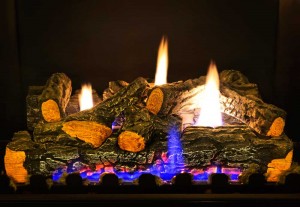A gas fireplace provides the appearance and heat of a wood burning version without the soot, ash, and other mess. Many people enjoy the realistic ambiance that gas fireplaces provide. However, if they live in homes with existing masonry chimneys, they may think that a gas fireplace is not an option. Good news: a gas fireplace can be installed in a home with a masonry chimney!

To ensure that desired gas fireplace is appropriate, have the chimney inspected by a certified chimney sweep. Though there are many compatible combinations, a very old old chimney and a high-efficiency gas fireplace may not be a good match. A higher-efficiency appliance produces less heat in its venting system. Some heat must escape from the chimney to create a draft that enables the system to operate.
Correctly matching a gas fireplace with a chimney venting system ensures that sufficient draft is present. An inadequate amount of draft may reduce both the safety and efficiency of the fireplace. Adequate draft pulls enough air into the fireplace for complete combustion. More than ten cubic feet of air is required for combustion of a single cubic foot of natural gas.
Incomplete combustion can produce carbon monoxide while complete combustion creates carbon dioxide. Increased carbon monoxide production is a health hazard and also indicates that less heat is being delivered to the home. A chimney inspection will reveal the size and type of gas fireplace needed to create complete combustion.
Before purchasing and installing a new gas fireplace, have a chimney inspection. This will prevent an improper match of the heating and venting systems. Selecting the correct gas-fueled fireplace system for the chimney present in the home will ensure many years of safe and comfortable use. Also, remember to have the chimney inspected annually and cleaned as necessary even when a gas fireplace is present.
